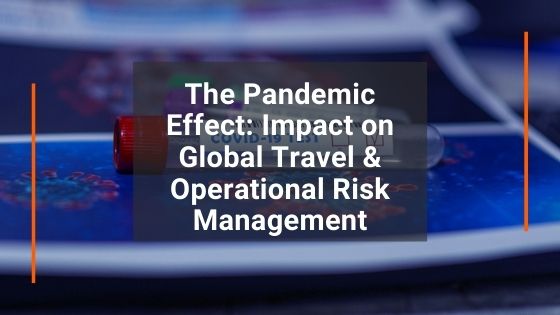The last couple of months have been jam-packed: the assassination of the Haitian president, violent unrest in South Africa, a coup in Mali., volcano eruption in the DRC, and cyberattack targeting USAID and NGOs. For the international development and NGO community, it’s been a strong reminder that COVID-19 isn’t the only risk confronting the community.
As the pandemic evolves and organizations increase travel and global activities, it’s increasingly important that operational risk management keeps pace. Paradoxically, while COVID-19 is far from the only risk out there, pandemic-related challenges influence risk management – even risks ostensibly unrelated to COVID-19:
- Health risks. With an increase in travel and operations, more personnel will encounter illnesses and injuries like those familiar in the pre-COVID-19 world – road traffic crashes, endemic illness, personal health conditions exacerbated by travel, etc. Unfortunately, the systems that personnel relied upon prior to the start of the pandemic are strained, in some places to the breaking point, reducing access to medical care. For example, patients seeking non-COVID-19 emergency medical care (think cardiac issue, road traffic crash) in India in recent months were challenged by a lack of beds, oxygen, or medical personnel due to the strain on the system caused by the pandemic.
- Travel challenges. A myriad of travel restrictions is still in place around the world, from pre-trip testing to mandatory quarantines. While most of these fall into the nuisance category, in some cases, travel disruptions can be significant – denied boarding, involuntary self-isolation, etc. A recent traveler on short-term travel to Cambodia was involuntarily quarantined after someone on their inbound flight tested positive for COVID-19 on arrival. After two weeks at a government-assigned isolation facility, the traveler moved to an apartment to begin their assignment, only to be quarantined again after someone in the apartment building tested positive.
- Security risks. In France and Cuba, recent unrest has been tied, at least in part, to pandemic-related policies and response, illustrating the impact COVID-19 can have on the wider security environment. Check out the Armed Conflict Location & Event Data Project (ACLED) for information about a range of COVID-19-related security events.
Management of security issues has been impacted by the pandemic, as well. In particular, the ability to depart a country during times of increased instability or unrest has been hampered by COVID-19 travel restrictions. Efforts to evacuate personnel from Myanmar following the coup were hampered by a requirement to show a negative COVID-19 test if transiting through Thailand – the commonly traveled route. Those seeking to leave Chad following the death of that country’s president faced similar challenges – especially those regional third-country nationals whose ability to travel through Europe was further limited by the need for visas in advance.

How best confront these challenges? In many ways, it’s back to the basics:
- Identify and assess risks. Understand the range of risks present in the environment – health and medical, safety/security, and travel-related. While some of these will present similarly to pre-COVID-19 days, some may be new or complicated by pandemic-related issues. Ensure that individual risk factors are included in any risk assessments – personal health conditions, gender, nationality, identity, etc. – all of which influence exposure to certain risks in various locations.
- Reconfigure or build mitigation and response plans. Refreshed risk assessment should lead to updated plans and procedures. In many cases, these will look similar to pre-COVID-19 measures – but with important revisions in some cases. For example, early engagement of HQ and assistance companies to support medical case management is even more important now that accessing medical care may be more complex and timelines for evacuations are longer given.
- Educate and inform. Ensuring personnel understands the risks and the systems in place to manage them has never been more essential given the changes in risk environments. And yes, even those “seasoned travelers” need pre-trip briefings and risk information. Not only have some risks evolved, but the systems in place to support risk management may have changed – most notably, challenges with availability of medical care locally and longer evacuation timelines. Clearly communicating these changes will help personnel better manage risk and set realistic expectations for support.
- Re-look at resources. Review capabilities and procedures with medical and security assistance services, go-to medical facilities, insurance, and other essential support resources to understand what may have changed based on the pandemic and other factors. And understand the practical implications and interconnectivity of these changes.
For example, a frequent question we get is whether COVID-19 illness is covered by insurance for internationally assigned staff or travelers. While specifics vary by policy, for the most part, the answer is yes (especially with Business Travel Accident policies). But that’s only part of the answer: While the illness may be covered by insurance (i.e. insurance will pay associated medical costs), managing a COVID-19 case for someone internationally will vary based on the capabilities of local medical facilities and resources which can be stretched thin. Additionally, medically evacuating someone with COVID-19 is complicated, requiring a specialized air ambulance vs a seat on a commercial flight (the more frequently used means of medical evac). And in some cases, a traveler with COVID-19 may have to be treated and recover in their destination if the severity of their illness doesn’t medically require them to depart.
As organizations resume global operations and travel, it’s essential to recognize the full range of risks – COVID-19-related and otherwise. And while COVID-19 is far from the only risk out there, the pandemic has re-shaped the risk landscape. The basics of risk management can help provide a framework for evaluating risk and building systems that can enable activities and travel while preparing team members to manage the inevitable risks they’ll encounter.






Recent Comments